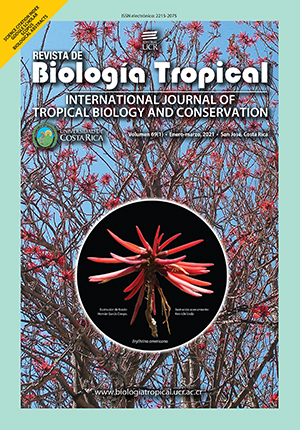Abstract
Introduction: Group or colony size is an important variable that is related to biological, ecological, and conservation aspects of bats. However, estimating the size of each colony or group in roosts used by more than one species is particularly difficult, especially when recapture rates are very low (< 10 %). Objective: Estimate the colony size of 14 species of bats: one emballonurid, one natalid, four mormoopids, seven phyllostomids, and one vespertilionid, which roosted throughout one year (July 2016 to June 2017) in a mine and two caves -Cerro Huatulco and El Apanguito- in the Sierra Sur and Costa of the state of Oaxaca. Methods: We constructed capture-recapture histories per species and roost, and for species for which we obtained recaptures that represented at least 10 % of the captures, we used the probabilistic Cormack-Jolly-Seber model. In the case of species with no recaptures or with a recapture proportion lower than 10 %, we estimated the number of individuals per roost by applying the same proportion between the number of captured specimens and the estimated number for species with recaptures greater than 10 % and that they belonged to the same family or trophic guild. Results: The total estimated number of bats in the three studied roosts was 20 105. The highest colony size estimates were for the mormoopids P. fulvus and P. mesoamericanus from El Apanguito and P. fulvus from Cerro Huatulco, with 6 609, 4 092 and 2 212 individuals, respectively. Conclusions: The methodology used in this study allowed estimating the colony size for all registered species, even though only for 21.42 % the recapture rates were greater than 10 %. Therefore, we consider that this methodology represents a viable alternative to estimate colony size in other roosts. This information, together with the high species richness and importance for reproductive processes, allow us to propose these sites as Bat Protection and Conservation Areas in Mexico.
##plugins.facebook.comentarios##

This work is licensed under a Creative Commons Attribution 4.0 International License.
Copyright (c) 2021 Itandehui Hernández Aguilar






